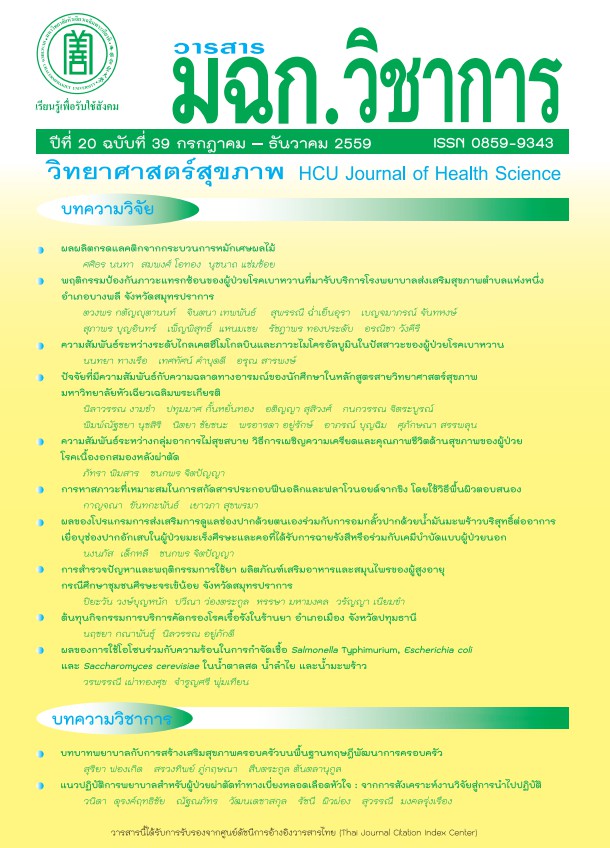The Clinical Nursing Practice Guideline for Patients with Coronary Artery Bypass Grafting: Research Synthesis for Application
Keywords:
Clinical Nursing Practice Guideline, Coronary Artery Bypass Grafting, Research synthesisAbstract
Clinical Nursing Practice Guideline (CNPG) for patients with Coronary Artery Bypass Grafting (CABG) was evolved from research synthesis which was developed by Cooper and Hedges (2007). It is composed of 1) determining to create CNPG 2) gathering 34 documents and researches published between the year 2003-2015. There were 4 articles related to systematic review, 7 articles related to randomized controlled trial, 1 article related to controlled trial without randomized, 2 articles related to case controlled & cohort studies, 16 articles related to case controlled & cohort studies, and 4 articles related to systemic review from descriptive and qualitative study 3) evaluating the quality of researches 4) Synthesis for finding results related to nursing care for patients with CABG and 5) Creating CNPG. The CNPG which created from the research analysis and synthesis composed of pre-operative phase, intra-operative phase, and post-operative phase. The pre-operative phase comprised of 1) health education for individualized patient and family, and 2) body and mind preparation before operation. The intra-operative phase comprised of 1) assessment of hemodynamics 2) following laboratory results, and 3) referring patients to the intensive care unit. The post-operative phase comprised of 1) caring for respiratory tract 2) assessment hemodynamic status 3) management bleeding 4) monitoring neurological status 5) caring for urinary tract 6) caring for gastrointestinal tract 7) pain management and 8) physical rehabilitation.
Downloads
References
Fischer, U. M. et al. (November 2002) “Impact of cardiopulmonary bypass management on postcardiac surgery renal function” Perfusion. 17 page 401-406.
Fredericks, Ibrahim and Puri. (4 December 2009) “Coronary artery bypass graft surgery patient education: a systematic review” Prog Cardiovasc Nurs. 24 page 162-168.
Freeland, K. et al. (4 October 2015) “Postoperative blood transfusion is an independent predictor of acute kidney injury in cardiac surgery patients” J Nephropathol.
4 page 121-126.
Garg, A. et al. ( 5 May 2014) Paraplegia during coronary artery bypass graft surgery caused by bilateral anterior cerebral artery territory infarction. 2 page 49.
Guo, P. East, L and Arthur, A. (February 2012) “A preoperative education intervention to reduce anxiety and improve recovery among Chinese cardiac patients: A
randomized controlled trial” International Journal of Nursing Studies. 49 (2) Pages 129–137.
Hannan, E. L. et al. (2007) “Off-Pump Versus On-Pump Coronary Artery Bypass Graft Surgery” Circulation. 116 page 1145-1152.
Hassan, M., Smith, J. M. and Engel, A. M. (6 June 2006) “Predictors and outcomes of sternal wound complications in patients after coronary artery bypass graft
surgery” Am Surg. 72 page 515-520.
Hillis, L. D. et al. (December 2011) “2011 ACCF/AHA Guideline for Coronary Artery Bypass Graft Surgery” Journal of the American College of Cardiology. 58 (24) page
e123–210.
Hulzebos, E. K. et al. (October 2006) “Preoperative Intensive Inspiratory Muscle Training to Prevent Postoperative Pulmonary Complications in High-Risk Patients
Undergoing CABG Surgery A Randomized Clinical Trial” The Journal of the American Medical Association. 296 (15) page 1851-1857.
Kua, J. et al. (November 2015) “Sleep apnoea is a risk factor for acute kidney injury after coronary artery bypass grafting” Eur J Cardiothorac Surg. 17 P ii : ezv382.
Lighthall, G. K. and Olejniczak, M. (2015) “Routine Postoperative Care of Patients Undergoing Coronary Artery Bypass Grafting on Cardiopulmonary Bypass” [Online] Available : http://maryland.ccproject.com/wp-content/uploads/2015/06/Lighthall-2015-Routine-PostOp-CABG.pdf (11 October 2015)
Lindblom, R. P. et al. (1 November 2015) “Outcomes following the implementation of a quality control campaign to decrease sternal wound infections after coronary
artery by-pass grafting” BMC Cardiovasc Disord. 15 page 154-158.
Lytsy, B. et al. (4 December 2015) “Hygienic interventions to decrease deep sternal wound infections following coronary artery bypass grafting” 91 page 326-331.
Mahla, E. et al. (2012) “Platelet Function Measurement–Based Strategy to Reduce Bleeding and Waiting Time in Clopidogrel-Treated Patients Undergoing Coronary Artery Bypass Graft Surgery The Timing Based on Platelet Function Strategy to Reduce Clopidogrel-Associated Bleeding Related to CABG (TARGET-CABG) Study” Circulation Cardiovascular Intervention. 5 page 261-269.
Mullen-Fortino, Margaret, O’Brien and Noreen. (1 January 2009) “Caring for a patient after coronary artery bypass graft surgery” Nursing Critical Care. 4 page 22–27.
Ohira, S. et al. (January 2015) “Impact of Chronic Kidney Disease on Long-Term Outcome of Coronary Artery Bypass Grafting in Patients With Diabetes Mellitus” Circ J.
80 page 110-117.
Oz, B. S. et al. (5 June 2013) “Pre-treatment before coronary artery bypass surgery improves post-operative outcomes in moderate chronic obstructive pulmonary
disease patients” Cardiovasc J Afr. 24 page 184–187.
Ravven, S. et al. (2 March-April 2013) “Depressive symptoms after CABG surgery: a meta-analysis” Harv Rev Psychiatry. 21 page 59-69.
Rezaianzadeh, A. et al. (3 December 2015) “Factors associated with extubation time in coronary artery bypass grafting patients” Peer, J. 3 page 1414.
Saxena, P., Abu, H. F. and Merry, C. (1 January 2012) “Spinal cord ischemia following coronary artery bypass surgery” J Card Surg. 27 page 45-46.
Savci, S. et al. (27 July 2011) “Short-term effects of inspiratory muscle training in coronary artery bypass graft surgery: a randomized controlled trial” Scandinavian
Cardiovascular Journal. 45 page 286-293.
Schopka, S. et al. (January 2014) “Impact of cardiopulmonary bypass on acute kidney injury following coronary artery bypass grafting: a matched pair analysis” Journal
of Cardiothoracic Surgery. 9 page 20.
Sevuk, U. et al. (2015) “Paraplegia due to spinal cord infarction after coronary artery bypass graft surgery” J Card Surg. [Online] Available : http://www.ncbi.nlm.nih.gov/pubmed/26553407 (11 October 2015)
Sirvinskas, E. et al. (6 November 2008) “Cardiopulmonary bypass management and acute renal failure: risk factors and prognosis” Perfusion. 23 page 323-327.
Sharif-Kashani, B. et al. (2015) J Surg Res. 21 (September pii: S0022-4804 15) page 929.
Downloads
Published
How to Cite
Issue
Section
License
บทความที่ได้รับการตีพิมพ์เป็นลิขสิทธิ์ของวารสารวิทยาศาสตร์สุขภาพและสุขภาวะ
ข้อความที่ปรากฏในบทความแต่ละเรื่องในวารสารวิชาการเล่มนี้เป็นความคิดเห็นส่วนตัวของผู้เขียนแต่ละท่านไม่เกี่ยวข้องกับมหาวิทยาลัยหัวเฉียวเฉลิมพระเกียรติ และคณาจารย์ท่านอื่นๆในมหาวิทยาลัยฯ แต่อย่างใด ความรับผิดชอบองค์ประกอบทั้งหมดของบทความแต่ละเรื่องเป็นของผู้เขียนแต่ละท่าน หากมีความผิดพลาดใดๆ ผู้เขียนแต่ละท่านจะรับผิดชอบบทความของตนเองแต่ผู้เดียว




